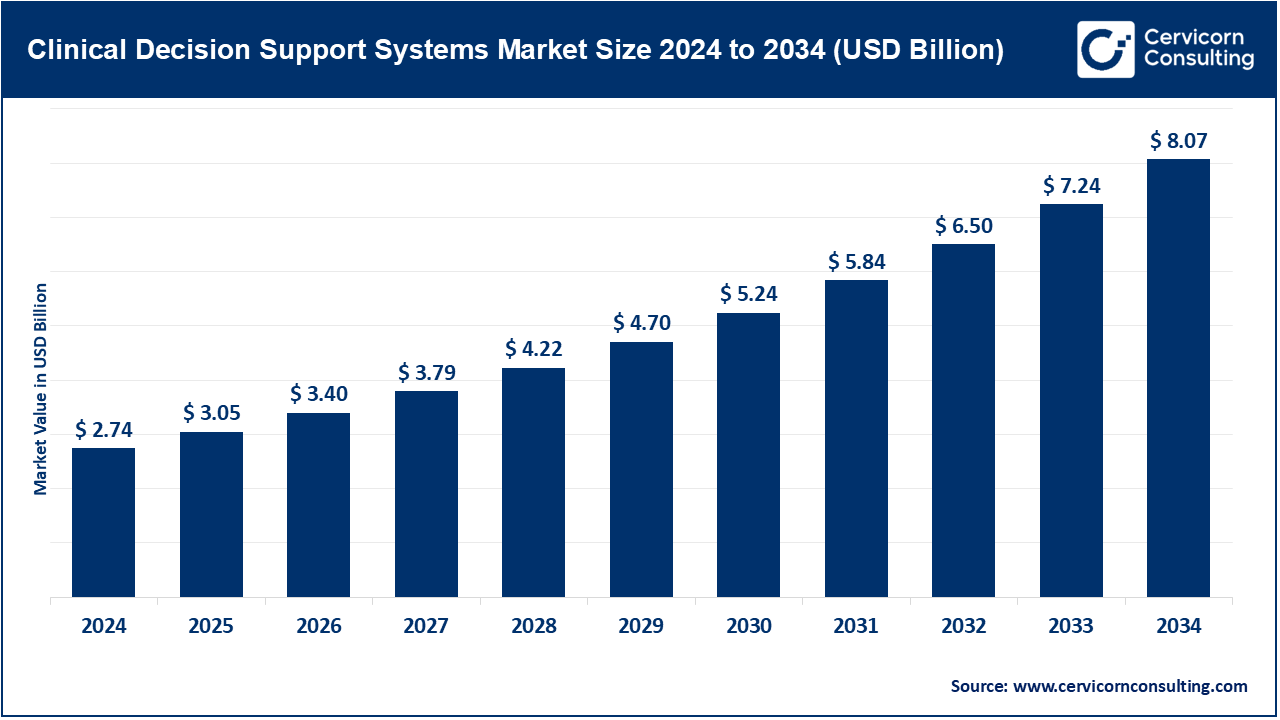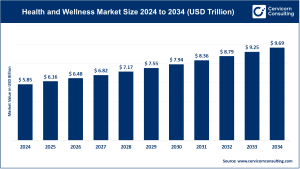What is the Clinical Decision Support Systems Market?
In 2024, the global clinical decision support systems market was valued at USD 2.74 billion and is projected to reach approximately USD 8.07 billion by 2034, growing at a Compound Annual Growth Rate (CAGR) of 11.41% during the forecast period from 2025 to 2034.
The Clinical Decision Support Systems (CDSS) market represents a pivotal segment within healthcare information technology, focusing on tools and systems designed to assist healthcare providers in making informed clinical decisions. These systems integrate with Electronic Health Records (EHRs) to offer real-time alerts, diagnostic support, treatment recommendations, and clinical guidelines, thereby enhancing patient care quality and safety.
Market Trends
-
Integration with EHRs and Interoperability Standards: The seamless integration of CDSS with EHRs has become increasingly important. Nearly 90% of doctors’ offices in the U.S. now use EHRs, with about 78% of these systems meeting government certification standards. Additionally, 78% of healthcare institutions are actively exchanging patient data in real time through systems that meet the HL7 FHIR standard, allowing information to flow smoothly from one provider to another.
-
Adoption of Artificial Intelligence (AI) and Machine Learning (ML): The incorporation of AI and ML technologies into CDSS has enhanced their capabilities, enabling predictive analytics, pattern recognition, and personalized treatment recommendations. These advancements contribute to improved diagnostic accuracy and better patient outcomes.
-
Shift Towards Value-Based Care: The emphasis on value-based care models has driven the adoption of CDSS, as these systems support clinical decision-making that aligns with quality care objectives, reduces costs, and improves patient satisfaction.
Get a Free Sample: https://www.cervicornconsulting.com/sample/2707
Market Dynamics
Drivers
-
Increasing Incidence of Chronic Diseases: The rising prevalence of chronic conditions such as diabetes, cardiovascular diseases, and cancer has heightened the demand for CDSS to support early diagnosis and effective management.
-
Government Initiatives and Support: Policies and incentives promoting the adoption of digital health technologies have accelerated the implementation of CDSS. Programs encouraging the use of EHRs and interoperability standards have facilitated the integration of CDSS into healthcare systems.
-
Technological Advancements: Continuous innovations in AI, ML, and data analytics have enhanced the functionality and accessibility of CDSS, making them more effective tools for clinical decision-making.
-
Economic and Operational Pressures: Healthcare systems facing budget constraints and workforce shortages are increasingly adopting CDSS to improve operational efficiency, reduce errors, and optimize resource utilization.
Restraints
-
Data Privacy and Security Concerns: The integration of CDSS with EHRs raises concerns about the protection of sensitive patient information, necessitating robust cybersecurity measures.
-
High Implementation Costs: The initial investment required for the adoption of CDSS, including infrastructure and training, can be a barrier for some healthcare institutions.
-
Resistance to Change: Healthcare providers may face challenges in adopting new technologies due to established workflows and potential disruptions.
Opportunities
-
Expansion in Emerging Markets: The growing healthcare infrastructure in emerging economies presents opportunities for the adoption of CDSS to enhance healthcare delivery.
-
Integration with Telemedicine: The convergence of CDSS with telemedicine platforms can provide remote patient monitoring and decision support, expanding access to quality care.
-
Development of Specialized CDSS: Tailoring CDSS to specific medical specialties can enhance their effectiveness and adoption among healthcare providers.
Regional Analysis
-
North America: Dominates the global CDSS market due to high healthcare IT adoption rates, government support for digital health initiatives, and a large number of healthcare institutions implementing EHRs and CDSS.
-
Europe: Experiences steady growth, driven by stringent data privacy regulations like GDPR, which encourage the adoption of secure and interoperable CDSS solutions.
-
Asia-Pacific: Represents the fastest-growing region, fueled by increasing investments in healthcare infrastructure, rising chronic disease prevalence, and government initiatives promoting digital health technologies.
-
Middle East & Africa: Shows gradual adoption, with select countries investing in healthcare IT to improve patient care quality and operational efficiency.
Recent Developments
-
AI Integration: Leading CDSS providers have integrated AI and ML algorithms to enhance predictive analytics capabilities, enabling early detection of potential health issues and personalized treatment recommendations.
-
Cloud-Based Solutions: The shift towards cloud-based CDSS platforms has facilitated scalability, cost-effectiveness, and remote access, particularly benefiting smaller healthcare facilities.
-
Regulatory Compliance: CDSS vendors are increasingly aligning their solutions with international standards and regulations, such as HIPAA and GDPR, to ensure data privacy and security.
-
Strategic Partnerships: Collaborations between healthcare providers, technology companies, and research institutions are accelerating the development and deployment of advanced CDSS solutions.
Conclusion
The Clinical Decision Support Systems market is poised for significant growth, driven by technological advancements, increasing healthcare demands, and supportive government initiatives. As healthcare providers continue to seek solutions that enhance decision-making and improve patient outcomes, CDSS will play a crucial role in shaping the future of healthcare delivery.
For more detailed insights and data, you can refer to the full report by Cervicorn Consulting: Clinical Decision Support Systems Market
Read: Cold Chain Market Innovations, Regional Insights, and Future Forecast

